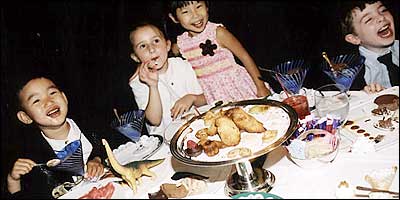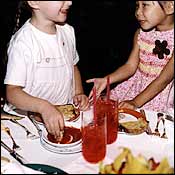|
Dining with children
at a five-star restaurant takes nerve, an iron stomach, and
the ability to use your noodle.
 |
| Linus, Willa, Jane, and Adrian (left to
right) learn spaghetti sucking and other essential skills. |
On the evening before my great
experiment, several of the parents called with words of comfort
and advice. They spoke in hushed, concerned, slightly amazed
tones, like I was contemplating going skydiving for the first
time, say, or scaling Mount Everest, or pondering some other
unimaginable, slightly rash, slightly loony act. “Alex
should be okay,” said Alex’s mom, “but if
the other kids get antsy and start moving around, I can’t
guarantee anything.” Linus’s mother wanted me
to know that if Linus began to misbehave (she thought there
was a good possibility that Linus would begin to misbehave),
I should threaten to take away the little plastic dinosaur
he carries with him at all times. Willa’s mom, Vicki,
tactfully suggested that I seat the boys and girls separately.
Then there was my own wife, who also happened to be Jane’s
mom, chiming in, a little less tactfully, with her own advice.
“Be sure to get the food coming fast,” she said.
“If you don’t, there’ll be anarchy.”
She wondered whether I could explain the menu to all the children
in stern, fatherly tones. “Run things like you’re
at a military camp,” she suggested. “If you don’t
get the kids to focus, you’ll be doomed.”
Probably she was right, but who really knew? I was venturing
into new, uncharted, and possibly treacherous territory. A
cosmopolitan, obsessively gourmet city like New York is filled
with child-friendly restaurants, of course. Inspect your Zagat
guide, and you will find restaurants that shower children
with buckets of crayons and stacks of coloring books, restaurants
with elaborately inventive menus (Serendipity), restaurants
themed around children’s toys (American Girl Cafe),
even restaurants where you can deposit your 2-year-old in
a playpen, then sit down for a meal (Sambuca).
But it was my rash, slightly loony idea to organize a children’s
dinner at one of the city’s exceptionally posh establishments,
one of those places you wouldn’t normally associate
with children of any age. If you showed up for an early dinner
with a gaggle of raucous though well-dressed nursery-school
children, would the maître d’ welcome you with
open arms, or would he bodily block the door?
When I posed the question to Eric Ripert, the chef and co-owner
of the great midtown seafood restaurant Le Bernardin, he offered
a diplomatic reply: “You don’t see Michael Eisner
coming to a power lunch with his children, if you know what
I mean.” But when children did appear, the staff did
their best to accommodate them. They prepared bowls of buttered
pasta, and Ripert himself often conducted tours of the kitchen.
Danny Meyer, proprietor of the Union Square Cafe and a father
of four, was even more effusive. At another of his restaurants,
Eleven Madison Park, he’d offered classes for children
on table manners and etiquette (which fork to use, proper
posture, who gets served first, etc.) that were so well subscribed,
the restaurant had to set up a waiting list.
 |
| Willa and Jane. |
“We accommodate children better than people know,”
said Meyer. “The Union Square Cafe is eighteen years
old this year. We like to get them young, so we have customers
who had their diapers changed in the restaurant and are now
coming back for their first bottle of wine.” But when
I mentioned I was planning to take not one but a gaggle of
4-year-olds out for a fine haute cuisine meal, Meyer sounded
bemused, then downright horrified: “I hope you’re
not coming to any of my restaurants,” he said.
The venue I chose for my little party was Le Cirque, arguably
the most lavish New York restaurant of all, which will, sadly,
be closing at the end of this year. The owner is a courtly
Tuscan gentleman named Sirio Maccioni, who, when I called
up to book a table, professed to love and welcome children
of any age. “Children are the future,” said Mr.
Maccioni in his flowery voice. “Bring ten if you like,
bring twenty—we will take care of them all.” I
settled on five, all of them from my daughter’s nursery-school
class. Along with Jane and her friend Willa, we invited three
boys, who were expected to create as much challenging chaos
as possible. There was Linus with his dinosaur; the quiet,
exceptionally well-behaved Alex; and Adrian, who arrived for
his dinner at Le Cirque in a tiny jacket and tie and clutching
in his hand a black plastic replica of Spider-Man.
“Chaos was
forestalled by the arrival of pommes soufflées, folded
in white napkins.”
At precisely 5:30 p.m. (no self-respecting restaurateur
would contemplate giving us a table any later), I gathered
the children in the foyer of the restaurant, while their parents
and babysitters sneaked off to calm themselves with cocktails
at the bar. Mr. Maccioni was conveniently out of town, leaving
his maître d’, Mario Wainer, to orchestrate the
occasion. Mario was dressed for the evening in his tuxedo,
and as the children began squealing and scampering around,
he smiled gamely and motioned us toward our table, which was
in the corner of one of the restaurant’s two great dining
rooms, with tall chairs covered in aqua-colored linen and
a high-backed, curving banquette made of crushed blue velvet.
Rows of empty tables were set in a protective ring around
our little party, and at the far end of the room, I could
see groups of adult diners looking our way with mounting suspicion.
I tried, as one mother had suggested, to alternate boys and
girls, but the boys gravitated to the chairs while the girls
sat primly on the banquette. The boys ordered lemonade and
the girls ordered Shirley Temples. The drinks came quickly,
and Linus asked for two straws, one for him and one for his
dinosaur. I’d been told that short, stumpy glasses are
best for kids (they don’t spill so easily), but these
glasses were tall, and when I made the mistake of distributing
menus, Adrian knocked his lemonade all over the table. Despite
the mess, we managed to order spaghetti, and then, as we waited
for our food, Linus held an empty wineglass to each ear and
began emitting high-pitched squeaking sounds.
ŅI can do lots of animal noises,” Linus cheerfully
announced.
“I can do them, too,” said Adrian.
“Woof, woof,” said Alex.
“Let’s all be animals,” cried the girls,
in their sweet, giddy voices.
Chaos was forestalled by the arrival of two stacks of pommes
soufflées, folded in white napkins. I described these
delicious little items (they’re lightly fried potatoes
filled with air) as “French- fry balloons,” and
soon the kids were calling them “balloonies” and
stuffing them into their mouths at a frightening clip. Linus
devoured 10 balloonies (or maybe 30), and my daughter, who
weighs barely 25 pounds, had 8. As the children stuffed the
balloonies into their craws, a sympathetic waiter sidled up
and asked if I’d like something stiff to drink. “No,
thank you,” I heard myself say, “but could you
please bring us some more balloonies.”
But the balloonies didn’t arrive soon enough, and
neither did the pasta, and as soon as the children sensed
a lull in the proceedings (when dining out with kids, I later
calculated, a lull is about 45 seconds), they began clamoring
for their parents. The boys bolted from the table first, running
off through the crowd, zigzagging around the waiters’
knees. The girls looked at me, and I looked at them, my face
contorted in a faux scowl of disapproval. But our little
standoff quickly ended when my daughter whispered, “I’m
sorry, Daddy, I just want to go tell Mommy that I love her.”
So off she went, and by the time I’d rounded them
all up, the pasta was on the table. Everyone liked the pasta,
so much so that a couple of the kids (Linus and Willa) began
eating with two forks. A wise parent told me that it was better
to let children play with their food than with each other,
and with this in mind, I organized a spaghetti-sucking contest
(won by Willa). But the spaghetti-sucking contest led to a
round of communal animal calls, which led to more glowering
from the grown-ups at the distant tables, and so, as our main
course was cleared away (“But, Daddy,” said Jane,
“there’s still lots of spaghetti on the floor”),
I brought out the crayons and paper.
Crayons and paper are the Kryptonite of the children’s
restaurant world, invaluable tools that render even the most
obnoxiously empowered 5-year-old momentarily passive and mute.
In our case, the relative calm lasted for about four minutes,
which was too bad, since it took ten minutes for the desserts
to arrive. In the delicate interim, the waiters distributed
little chef’s hats, which some of the kids wore and
some didn’t (Linus put his on top of his dinosaur).
Then, when the desserts arrived, a few of the kids didn’t
know what to make of them. Alex stared blankly at a multilayered
napoleon dusted with powdered sugar, and Adrian continued
to draw quietly, clutching a handful of crayons in his tiny
fist (“I’m making scrambled eggs,” he said).
Willa received a little stove made all of chocolate, which
she and my daughter took apart, then ate, piece by piece,
in their precise, feminine way. Linus appropriated Alex’s
napoleon (in the process of which Alex spilled his lemonade),
and soon great clouds of powdered sugar covered Linus’s
jacket and face.
My notes on the rest of the meal are messy and imprecise,
as if they were jotted in the middle of a windstorm. At one
point, bowls of ice cream arrived, and after a period of intense,
lip- smacking silence, the table was buffeted by a great,
collective sugar rush. According to my notes, Linus pointed
to me and said, “Mr. Platt, there’s a big lizard
on your head.” Shortly afterward, dinner ended. Danny
Meyer said his biggest worry when serving young children in
his restaurants is to keep the parents from losing their heads,
and so it was at Le Cirque. The table looked like a bomb had
hit it, but the waiters buzzed around with merry smiles on
their faces, picking through the layers of debris. As the
children rushed to and fro, the parents emerged from the bar
to survey the wreckage.
“How was it?” my wife wanted to know.
“It was fun,” I said, which was more or less
the truth.
Then Mario appeared, looking unruffled in his tuxedo, grinning
his friendly, professional grin.
“What a lovely party,” he said, giving a little
bow.
“You must be kidding, Mario.”
“Oh, this was fine. It was very amusing to watch.
”
Then he handed me a Le Cirque bag. Inside were the crayons,
neatly packed, and boxes of leftover cookies and chocolates.
“A little something for the children,” said
Mario. “Please come again.”
Adam Platt is a restaurant critic for New York Magazine.
|